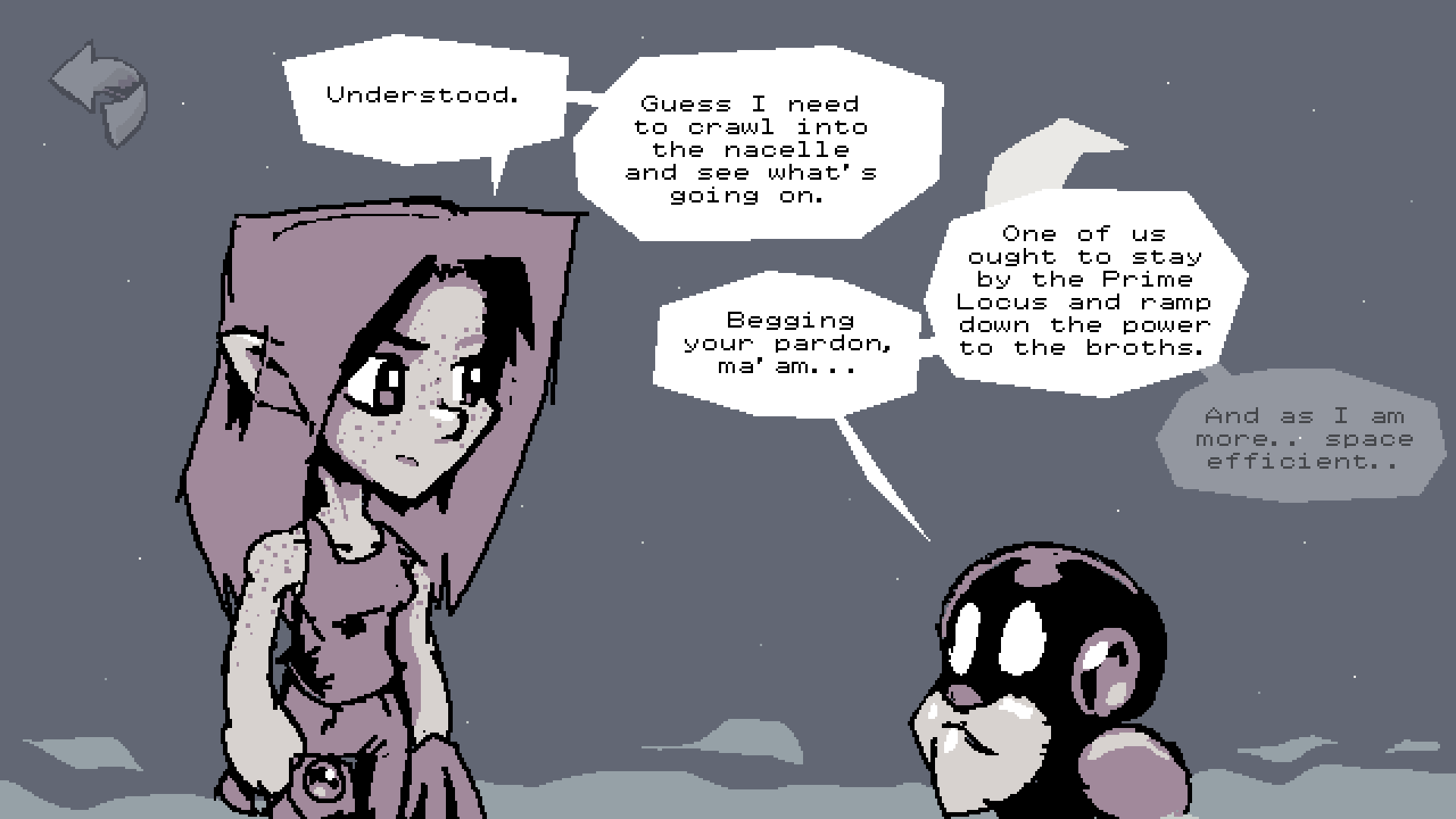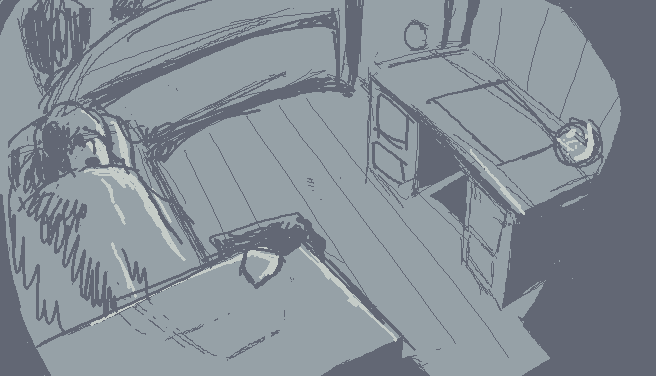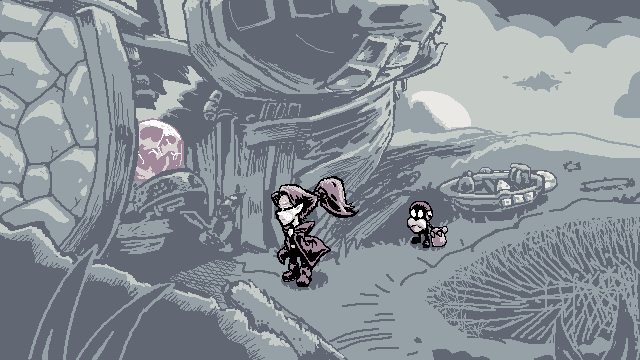Hypercomic Premortem
In my devlog for Toasty, I mention that between making children's books, I occasionally make small games, usually in a jam.
I also use jams to test ideas. For instance, for last year's GMTK jam, I made Royal Pain to test whether I could throw together a little platformer, handling everything except the sound.
Well. I can draw. I can code after a fashion. I love games, but I also love comics and illustrated books. And I have a bunch of stories in my head I want to get out.
The thing is, games qua games are not the best medium for telling a story that's in your head, with characters and a plot. The strength of games is building a story with your player. Environmental storytelling. But there is a medium that lies between. The Visual Novel.
The Hypercomic: Defeating My Prejudice
I have, from time to time, attempted to make a Visual Novel, but I've never seen it through. The problem is, to my mind, a VN is just the cutscene half of a JRPG. Now, there are a handful of JRPGs I enjoy. Older Pokemon games. Mario RPGs. But whenever I've sat down to make one with RPGMaker OR Godot, I ran out of steam before I got anywhere. Walking around isn't gameplay. Dialogue isn't gameplay. What is the point, my brain says, of making a game when you never get to the gameplay? Why not just write a book or a comic if you are going to spend all the time on story and setting and so forth?
But I have made books. And I have made comics. And the lack of gameplay doesn't bother me there.
The issue, I realized, is that I think of VNs as games. And that's not necessarily a bad framing. It's as much a game as a Choose Your Own Adventure book, and often much more. But it's a bad framing in my head. In my head, I am taking a genre with certain strengths and siphoning away the strengths, leaving only the weaknesses.
But what, I speculated, if I thought of VNs not as games with interactivity stripped out, and instead thought of them as comics with interactivity layered in?
Thus was born the Hypercomic. A mental reframing of Visual Novels. I'm starting with a comic, and adding to it.
The Plan: Godot Wild Jam #65 - OVERLOAD
So I knew I was going to work in pixel art. I knew I was going to make a Hypercomic. I knew I was working in Godot. As much as it pains me to give up a lot of the expected functionality of a Visual Novel, such as saving and loading, the hotkeys expected by the community, and so forth, that I would automatically get with, say, RenPy, I wanted to have more direct control over how everything in the program went down. After all, this wasn't a Visual Novel, this was a Hypercomic. Instead of two characters standing in front of a background speaking in text boxes, I would have two characters standing in front of a background speaking in speech bubbles. Totally different thing.

What I needed was a story. Not one of the dozen long stories brewing inside me that would take months or years to complete. Something I could write and illustrate, albeit crappily, in a weekend. Something to test the concept.
A game jam would be perfect. The theme of the jam would give me constraints I could squeeze into a story. So I looked up the soonest Jam that would permit my tools and direction, and enrolled in the Godot Wild Jam 65.
The Theme was Overload. So I decided to take my character Wren and overload the engines of her airship. The Wildcards were
- "Have more than one win condition," so, even though a Hypercomic is not a Visual Novel and does not necessarily have more than one ending, I decided to give the player a range of things to choose from resulting in a bad ending where the ship blows up, and a mix of bittersweet to happy endings where our heroine prevails.
- "Tell a story through environment, not dialogue," uh... hard call with something that was basically a comic strip with a "next panel" button, but I resolved to be open to possibilities should they arise.
- "Allow the player to choose between characters", so I gave Wren a Piqha crewmember -- after all, it makes sense that she couldn't operate the ship by herself -- and designed the story to split them up near the beginning, with the hope that, if there was time, I could add a separate story arc or set of arcs where we follow the Piqha.
Now, if you've played the comic, you know that none of this really panned out. There are two, count 'em, two plotlines. One kinda-sorta bittersweet, and the other victorious.
The Plan Goes Wrong
Despite participating in half a dozen game jams, and finishing well in two or three of them, I somehow still managed to dramatically overestimate how much I could do in the time I had. Every. Single. Time.
From the Saturday Afternoon just before it ended until Thursday Morning four days after it ended, I had just one more picture I needed to draw, one more scene I needed to script, and then it would be done. But I was not discouraged when I passed the time limit. After all, I needed to know what it took to make a hypercomic, and how I felt about it as a storytelling medium.
Dragging it across the finish line four days late is not so bad. I have a day job. So that's 8 hours of unexpected work. But I axed multiple plot lines from each of the two main branches, as well as the plot line where we follow Mister Yamban as he tries to save the day.
I was hoping in my heart of hearts to include some form of gameplay as well. An overload meter that climbs as you make harmful choices, or lowers as you make good ones. But never manifested.
I was also far too precious about my art. I started strong, with a scribbled scene. After all, this is supposed to be a draft. We can (and will) come in and clean it up later. But I spent far too long nitpicking about minor details in some of the later scenes instead of making them fast and sloppy.


But, for all that went wrong, everything that needed to go right did go right.
The Plan Goes Right
Wren Valen Makes a Delivery is not a great work of art. It is a test. And the test taught me some stuff.
- I need to invest some time in those speech balloons. Right now, they are labels with attached polygons. They should have outlines, to separate them from chaotic or moving backrounds. They should have rich text labels, so I can use bold and italics. And they need to be far, far easier to wrangle for me to attempt a larger-scale project.
- I need to be less precious about my art, at least for the draft.
- Godot's integer scaling is wonky. If I want to do pixel art panels, I am better served handling the scaling myself.
- I should hide lore dumps in the scenery instead of using dialogue. Wren shouldn't tell the player outright things like what an aether broth or a prime locus is. Instead, I should let the player choose to engage with the encyclopedia entries, or not, according to his whims.
- Much as I love chiptunes, it may be better to use a wider range of styles.
- I need better ways to organize my panels. Right now, I've got a list of Resources that are a friendly name and the path to the file, and it's unwieldy. If the story is going to be more complex, it needs to be more wieldy.
- And finally, Yeah. This works for me as a story-telling medium.
Conclusion
I don't think I'm going to turn around and whip up another hypercomic next week.
I think in March, I will come back and polish up this one. Fix the spelling and grammar issues. Allow myself to be precious about the art.
But there shall be more hypercomics.
Wren Valen Makes a Delivery
A Hypercomic by E. Darwin Hartshorn
| Status | Released |
| Author | Bunny Trail Junction |
| Genre | Visual Novel |
| Tags | Fantasy, Godot, hypercomic, Pixel Art |
| Languages | English |
| Accessibility | Color-blind friendly, High-contrast |

Leave a comment
Log in with itch.io to leave a comment.